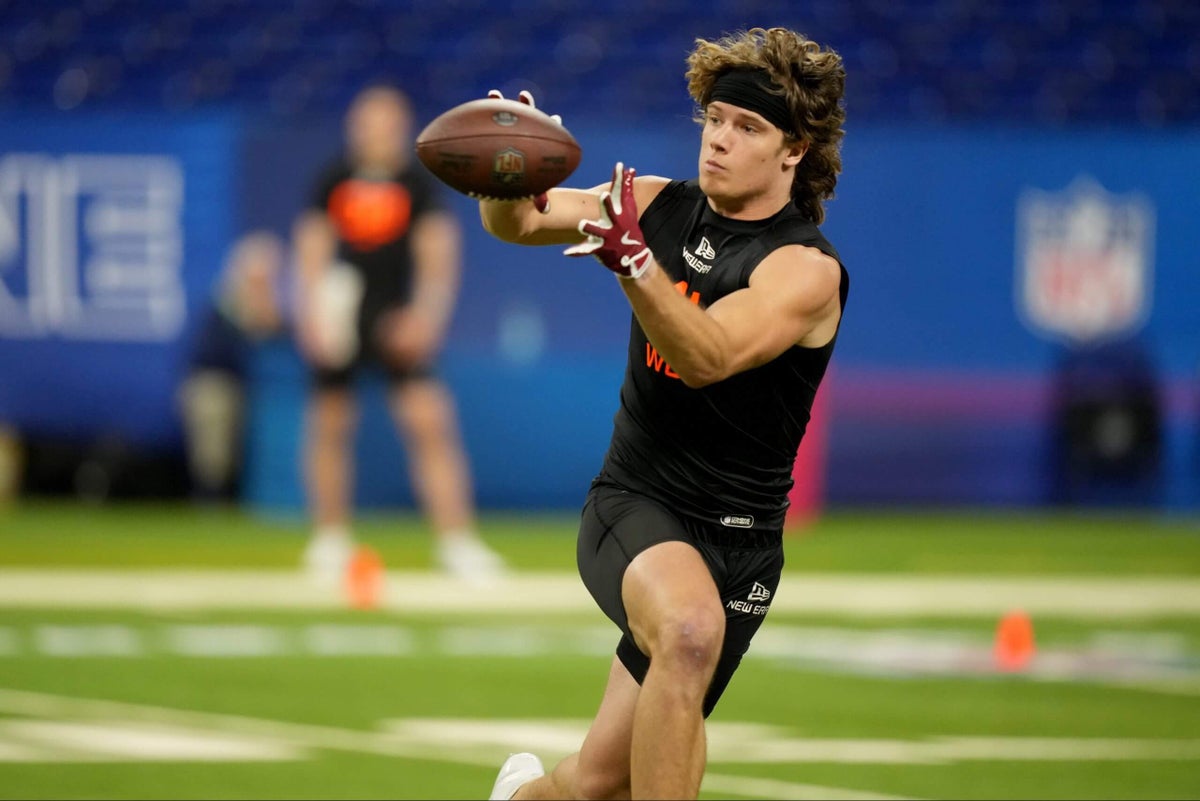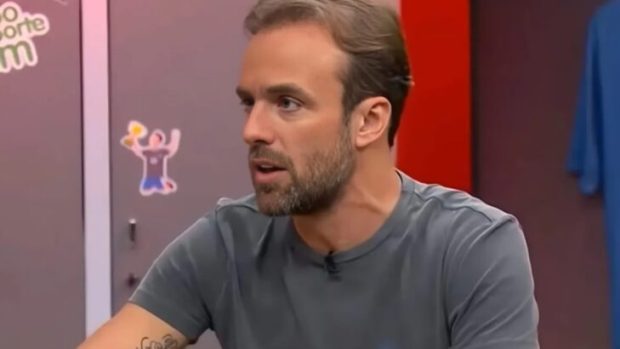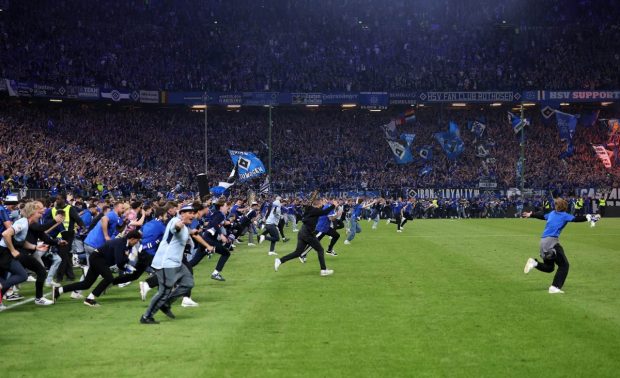

The Detroit Lions, more than most teams, have a type when it comes to prospects.
You’ll often hear draft experts refer to certain prospects as a “Dan Campbell guy” or a “Brad Holmes kinda guy.” We have five years of evidence that supports what they typically go after. But it’s not the typical length or speed requirements you’ll often see teams enact. The Lions certainly don’t shy away from athleticism, despite what their HWS hoodies suggest, but if the world is gushing over a prospect because of his traits and the Lions don’t see the vision, they’re not going to follow consensus.
Advertisement
They have to see the total package, regardless of where it comes from. They saw it in each of the prospects they selected.
Ohio State DT Tyleik Williams
On-field fit: Williams is an agile, nimble defensive tackle with a high football IQ. He was arguably the best run-defender in the class, which gives him a high floor as a prospect. The NFC runs through Philadelphia, so adding a run-stuffing lineman to a team that already defends the run well is intriguing, particularly with DJ Reader and Levi Onwuzurike in contract years. But many believe there’s some untapped potential in Williams’ game. Larry Johnson, the longtime Ohio State defensive line coach who’s developed the Bosas, Chase Young and others, told reporters he’s never been around a defensive tackle like Williams because of this combination. Holmes said Williams reminds him of a younger Alim McNeill in many ways. McNeill was viewed as a nose tackle coming out of N.C. State with untapped pass-rush potential. Because he was already a force in the run game, turning his movement skills into pass-rush production would make him one of the league’s most well-rounded young defensive tackles in the league. McNeill put in the work to make it a reality and was rewarded with a $96 million extension. Williams knows he has work to do before he finds himself at McNeill’s level, but he has the tools and desire to be great.
Character fit: Of course, there’s so much more that goes into the evaluation than the on-field fit. When Williams first got to Ohio State, he weighed between 360 and 370 pounds. That was unplayable, so he spent the majority of his freshman year working with the program’s nutritionist to slim down. By the next year, he weighed 317 pounds. It’s a testament to his commitment to being his best, and something McNeill himself did to elevate his game.
One thing Williams talked about was returning to Ohio State for one last run at a national championship with the guys he came into the program with. After their loss to Michigan late in the year, a team meeting was called between players and head coach Ryan Day. Williams, a fourth-year senior, said the Buckeyes had issues that needed to be ironed out. The leaders for the Buckeyes spoke up, got the rest of the team headed in the same direction and won it all. That’s a tough conversation to have, but it proved he has a championship mindset and an ability to focus on the task ahead when facing pressure. Have to think the Lions loved that.
Georgia G Tate Ratledge
On-field fit: Ratledge, The Athletic’s 3rd-ranked guard, was a four-year starter at Georgia, winning two national championships along the way. He’s another player who comes equipped with a championship pedigree and mindset. He takes it personally when the defense gets a hand on his quarterback. Georgia is a team that runs out of zone and gap, which is rare for college programs. The Lions have the most diverse run scheme in the NFL, so being able to do everything in the run game is important. Ratledge majored in it. In pass protection, he can recognize blitzes quickly and isn’t fooled by stunts. He was rarely penalized in college, has strong practice habits and loves the game. You don’t have to do much projecting here.
Advertisement
Character fit: Ratledge was a team captain for one of the best programs in the country, receiving 95 percent of the votes from Georgia’s 130-man team. That’s the ultimate sign of respect, earning an honor like that at a school like Georgia. But he’s not the hyper-serious type, either. He’s got an everyman personality, which makes him relatable to everyone. He loves to hunt. He sports a free-flowing mullet out of a movie that was started as a joke and continued for the bit. A year ago, he got a tattoo of a Lion on his right arm. Little did he know where he’d end up. It won’t take long before he endears himself to Lions fans.
Arkansas WR Isaac TeSlaa
On-field fit: The Lions were in the market for a young receiver, and might’ve found their next weapon for years to come. At 6-foot-4 with 4.43 speed, TeSlaa is an exceptional athlete with great hands and a blocker’s mentality. That’s what first stood out to Holmes at the Senior Bowl. TeSlaa was constantly working to the second level to block safeties and “pissing off” DBs as a blocker, Holmes said. It’s not hard to understand why. TeSlaa has always been a grinder (more on that later). He transferred from Division II Hillsdale College to the SEC at Arkansas, putting up solid production over two years. Despite his size, Arkansas primarily used him as a slot receiver, where he won with quick outs, hitches, crossers and drags when he wasn’t stretching the field and blowing by safeties with his speed. If he’s going to be an X receiver in the NFL, he’s going to need more reps against physical corners in press man. He’ll get that in Detroit, and if he continues to develop, the sky is the limit in this offense. His combination of athleticism and film separated him from others for the Lions, which is why they were comfortable trading up for him.
Character fit: TeSlaa has a great story, and that story is likely the reason Holmes said TeSlaa was his favorite receiver in this draft class. He grew up rooting for the Lions, raised in Hudsonville, Mich. He was in attendance when Calvin Johnson set the NFL’s single-season receiving record. During his 30 visit with Detroit, TeSlaa wore a custom-made Lions jersey with his name on the back — a move Holmes thought was cheesy at first until he realized TeSlaa is a confident cat. A zero-star recruit who played QB in a wing-T offense in high school, TeSlaa didn’t have tape at WR. He was offered a partial scholarship at Valparaiso before accepting a full ride at Hillsdale. After an All-American season in 2022, TeSlaa earned FBS looks from Colorado, Iowa, Miami, Ole Miss, Nebraska, Texas A&M and Wisconsin others, before choosing Arkansas. He’s come a remarkably long way to get to this point. His story is an inspiring one, and that story is why the Lions are confident he can realize his potential.
TeSlaa was at a loss for words trying to describe the feeling of playing for his favorite team, given what it took to get here. And since he’s only been playing receiver for a few years, there’s still so much he can learn. If he’s able to maximize his athletic tools and develop under WRs coach Scottie Montgomery, the draft capital it took to acquire him will be forgotten.
The moment Isaac TeSlaa’s family and friends found out he was going to his hometown team. pic.twitter.com/ZCSvHOWA53
— Pride of Detroit (@PrideOfDetroit) April 26, 2025
LSU G Miles Frazier
On-field fit: Frazier, a transfer from Florida International, played two years for LSU. At LSU, Frazier was a starting right guard along one of the better offensive lines in the country, with four of the team’s five starters drafted this year alone. He also was the backup at left and right tackle, and while he lacks the length to be a full-time tackle in the NFL, he has the ability to play there in a pinch if needed. The Lions didn’t need to draft another guard after selecting Ratledge, but the fact that they did shows a commitment to their offensive line, competition and drafting the best players available. Frazier was sticking out like a sore thumb in the fifth round, given a third-to-fourth round grade by The Athletic’s Dane Brugler. The Lions traded up from No. 182 in the sixth to No. 171 in the fifth to select him. He’ll serve as depth as a rookie, but with Graham Glasgow getting older, he could find himself competing with Christian Mahogany for a starting role in the near future. The Lions might’ve found a starting-caliber guard in the fifth round.
Advertisement
Character fit: Frazier pairs his impressive size for a guard (6-foot-6, 317 pounds) with a mauler’s mentality. It started at FIU, where he worked his way from two-star prospect to Freshman All-American before the staff that recruited him was fired. Frazier used the opportunity to transfer to the SEC to prove his worth against better competition. His position coach at LSU, Brad Davis, instilled the idea of style points — extra effort, knockdowns, pancakes — in his room. It shows on Frazier’s tape. The unit was called the “bomb squad,” and Frazier has a tattoo of it on his shoulder. Frazier said Davis told him if he doesn’t do his job, his quarterback gets hurt. He took that knowledge to heart, allowing just four sacks in his three years at LSU, and zero in his final season. When his career is over, Frazier said he wants to be a coach like his older brother, M.J, who played football at North Carolina A&T — just like Holmes. A strong fit for an offensive line that’s been one of the NFL’s best recently.
Boise State Edge Ahmed Hassanein
On-field fit: Pretty much everyone was begging the Lions to draft an edge rusher, but it had to be the right fit. Holmes made calls to move up and select a couple he liked on Day 2, but there were no serious takers. Instead, he stuck to his board, waited on one, and left with Hassanein — a prospect who fits everything they’re about. Hassanein isn’t an elite athlete and isn’t the first-off-the-bus body type. He is a pest, though, in the best way. In college, he won with his relentless motor, often cleaning up disrupted plays and finishing the job. It led to impressive production: 24 career sacks and 34 tackles for loss. He’s not the answer to Detroit’s long-term edge question, but if he’s able to come in on passing situations and clean things up from time to time, you’ll take it as a sixth-round pick. Especially the way he’s wired.
Character fit: Like others on this list, the story reveals why the Lions drafted Hassanein. Born in Orange County, Calif., Hassanein lived in the U.S. with his father until he was six, before moving to Cairo, Egypt. He was a boxer, wrestler, learned judo and jiujitsu and was the No. 1-ranked CrossFit athlete in Egypt. He moved back to the U.S. in high school, but only knew how to speak Arabic. Sports helped him assimilate. Hassanein started playing football his junior year, learning from his half-brother — a former Division II football player and current high school English teacher/coach in the U.S. — and by watching videos of Aaron Donald. Hassanein didn’t know what the NFL was until he watched Donald play. But he put enough on tape to earn several offers before committing to Boise State, using his motor and competitive drive to propel him. He would lead the team in sacks and TFLs his final two years, eventually earning team captain status and helping the Broncos reach the College Football Playoffs this past season. His work ethic is what got him here.
In many ways, Hassanein is a coach’s dream. He’s a high-character individual who flips a switch when he’s on the field — often yelling at himself to hype himself up before a play or a drill. That intensity is evident when you talk to him. You can feel it through a screen. A try-hard in the best way possible. He said offensive linemen hate going against him because he never stops. If he gets knocked down, he’s bouncing right back up. If he gets a sack, he lines up and tries to get another. His physical limitations are likely to show up in his game at the next level, but it’s obvious why the Lions liked him. He fits everything they’re all about.
Georgia S Dan Jackson
On-field fit: Safety depth was something the Lions needed, as former No. 3 safety Ifeatu Melifonwu is now with the Miami Dolphins. It’s unclear if Jackson will develop into a reliable third safety, but at the very least, he’s a player who can help this team. A seventh-round pick out of Georgia, Jackson’s best path to making the roster is through special teams. It’s something Holmes acknowledged. Knowing Jackson’s story and how he ended up at Georgia in the first place, he’ll be willing to do whatever it takes to prove himself valuable to special teams coordinator Dave Fipp. If that happens, there’s a place on this roster for Jackson. And if he continues to develop and impress with his knowledge of the game, don’t rule out the idea of him seeing defensive snaps as a reserve safety. He’s a seventh-round pick worth betting on.
Character fit: Jackson, a zero-star recruit who’s only offers came from Air Force and FCS Mercer, is a Georgia native who spent his weekends in Athens going to Bulldog games. Despite minimal collegiate interest until his senior year, Jackson eventually walked on at Georgia in 2019. He passed up scholarship opportunities to attend his dream school, willing to outwork the four- and five-star prospects ahead of him on the depth chart. He said he chose Georgia because he wanted to win and wanted to be around the best. Head coach Kirby Smart didn’t plan on Jackson becoming his starting safety when he accepted him as a walk-on, but eventually, his presence was undeniable. He was a core special teamer for Georgia and earned his first start in 2021 after two years on scout team. He wasn’t given a football scholarship in his six seasons at Georgia and almost gave up football prior to the 2024 season, but returned for another year and raised his draft stock. He became a starter and a team captain (alongside Ratledge) in his final season at Georgia. He said it was one of the highest honors of his career, coming from a guy who won two national championships. The story of a six-year walk-on finding his way onto arguably college football’s most talented program and getting drafted is one you can’t help but admire. Continue to overlook him if you must, but he just might find his way onto the field in Detroit.
Georgia WR Dominic Lovett
On-field fit: The Lions WR room has five players currently locked to make the team in Amon-Ra St. Brown, Jameson Williams, Tim Patrick, Kalif Raymond and TeSlaa. Will they have room for a sixth? It depends how Lovett performs and if he can force himself into the conversation in training camp. A smaller wideout at 5-foot-10 and 4.41 speed, Lovett primarily worked out of the slot at Georgia, and offered solid production for QB Carson Beck. His skill set might be a bit redundant, but Lovett has a chance to change the conversation if he can offer value on special teams. He was a gunner on punt return at Georgia. Perhaps he can add return responsibilities to his plate? If so, it would likely make him a more difficult cut when it comes time to settle on a 53-man roster. At the very least, though, Lovett has enough talent to stick around on the practice squad and continue developing. Carving out a Raymond-esque role in the NFL would likely be his best chance at sticking around.
Advertisement
Character fit: Lovett, before transferring to Georgia, played football at Missouri alongside former and now current teammate Ennis Rakestraw Jr. Lovett was asked about Rakestraw and those battles. He said they made each other better and would often get the best of one another. After practice, they should exchange tips to help each other on Saturdays. It’s an iron sharpens iron mentality that led him to transfer to Georgia — he wanted to go up against the best competition. He believes Georgia’s hard practices will prepare him for the NFL. He experienced them for two years as a starting slot receiver. While he didn’t play special teams at Missouri, he did at Georgia — carving out a role on special teams upon arrival. It’s likely what led him to this point. Lovett told local media he wants to make an impact anyway he can, hoping to find his way onto the field. He’s wired the right way.
Just like others on this list.
(Top photo of Issac TeSlaa: Kirby Lee / Imagn Images)
This news was originally published on this post .











Be the first to leave a comment